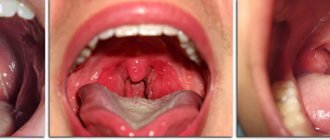Every person experiences a sore throat sooner or later. But this seemingly harmless symptom can cause serious problems.
Acute tonsillitis (tonsillitis) is an infectious disease that causes inflammation of the tonsils. Statistics show that about 15% of children suffer from an acute form of the disease. In the adult population, this figure is lower - 5-10%. But almost every person in large cities suffers from chronic tonsillitis. Why? Let's find out!
The acute form of tonsillitis, which goes away with an increase in body temperature and severe pain in the throat, is more familiar to us as a sore throat. In the chronic form, the patient may not even realize that he has this disease for a long time. A person may feel that periodic sore throats and frequent colds are simply the result of a weakened immune system. Such a careless attitude towards one’s health can cause serious complications and pathologies. To avoid them, it is necessary to diagnose the problem in time: know the first signs, symptoms and treatment.
Make an appointment right now!
Call us by phone or use the feedback form
Sign up
Why are tonsils needed?
The tonsils are an integral part of our immune system. And their main purpose is to protect the body from the penetration of pathogenic bacteria and viruses. In total, a person has six of them: palatine and tubal (paired), pharyngeal and lingual. By their names you can roughly understand in which part of the pharynx they are located. Their general arrangement resembles a ring. This ring acts as a kind of barrier for bacteria. When we talk about inflammation of the tonsils, we mean only the palatine tonsils (aka tonsils). Let's look at them in more detail.
If you open your mouth wide, then in the mirror you can easily see two formations that look like almonds - tonsils, these are tonsils. Each tonsil consists of small openings (lacunae) and winding canals (crypts).
Bacteria that enter the air, in contact with the tonsils, are rebuffed and are immediately disposed of, without having time to cause an outbreak of a particular disease. Normally, a healthy person does not even suspect that real fighting is taking place inside him. Now you understand the importance of the mission of the palatine tonsils. Therefore, a good otolaryngologist will never rush to recommend their removal. Although to hear from a doctor, speaking about tonsils: “They need to be removed!” - a common phenomenon in our time. Unfortunately, today not all clinics can offer high-quality treatment for tonsillitis, and sometimes the turnaround rate is off the charts. That is why it is sometimes easier for a doctor to brush it off and refer the patient for surgery.
Treatment
Treatment directly depends on the causative agent of inflammation. In most cases, these are bacteria, so doctors prescribe antibiotics; if there is no improvement in the first few days, the treatment regimen is changed. Chronic inflammation of the tonsils should be treated using physiotherapeutic techniques to enhance the effect.
How to treat at home
The doctor will recommend how to treat inflammation of the tonsils at home and what medications to take. Patients must strictly follow the regimen and adhere to the dosage of medications. In addition to taking medications and medications, to treat the tonsils, you need to gargle and take pills to relieve pain. For inflammation caused by a fungus, the tonsils are treated with antifungal drugs.
Medicines and drugs
Therapy begins with the use of antibiotics. First of all, tablets are recommended for inflammation of the tonsils - Ampicillin, Cephalexin, Amoxicillin. They are taken in a course, the dosage depends on age.
Antimycotic solutions are used to treat tonsils; they resist the proliferation of fungus and normalize the microflora. Recommended products for use are Candide, Fucis, and Ketoconazole.
Since patients with inflammation of the tonsils suffer from a sore throat, remedies that relieve discomfort are necessarily recommended. Among such drugs, the most popular lozenges are Septolete, Strepsils, and Grammidin.
As maintenance treatment, the patient will be recommended immunomodulatory drugs and multivitamins. Immunal and Imudon give a good effect.
How to gargle
Rinse solutions can be used to cleanse the surface of the tonsils from pathogenic bacteria, decay products and toxins. Good effect from Chlorophyllipt, Furacilin. The same can be done if the tonsil is inflamed on one side.
The listed drugs are not the only means of treatment if the tonsils are inflamed. A popular solution is soda with salt and iodine. Add one teaspoon of salt and soda to a glass of warm water, stir until completely dissolved, then add 3-4 drops of iodine. It is necessary to gargle with the resulting product every two to three hours.
Lemon juice is a natural antiseptic, which can also be used as a gargle for inflammation of the tonsils. Dissolve the juice of half a lemon in a glass of warm water and rinse the mouth with it. In addition to the rinses discussed above, solutions of herbs are also used - chamomile, calendula, oak bark.
Before treating inflamed tonsils with herbs, make sure there is no allergic reaction.
Types of tonsillitis.
The disease occurs in two forms - acute and chronic. Acute tonsillitis is an illness of an infectious nature and manifests itself in acute inflammation of the tonsil. The cause of exacerbation is staphylococci and streptococci. Acute sore throat in children and adults is also divided into catarrhal, follicular, lacunar, ulcerative-membranous and necrotic.
Chronic tonsillitis is a long-term, persistent inflammatory process in the tonsils. It manifests itself as a consequence of past inflammation, acute respiratory viral infections, dental diseases, and reduced immunity. Chronic exacerbation of the disease in adults and children occurs in three forms: compensated, subcompensated and decompensated. In the compensated form, the disease “dormants”; exacerbation of tonsillitis symptoms occurs infrequently. In the case of a subcompensated form of the disease, exacerbations occur frequently, the disease is severe, and complications are common. The decompensated form is characterized by a long, sluggish course.
Symptoms of tonsillitis.
A symptom that combines both types is pain in the throat. The pain can be both severe and tolerable. The patient experiences severe discomfort while eating and swallowing.
Sore throat is much more severe than a chronic disease and is accompanied by the following symptoms:
- increased body temperature (up to 40°C);
- very severe sore throat;
- enlarged lymph nodes;
- accumulations of pus on the tonsils (plaque, pustules);
- enlarged tonsils;
- headache;
- weakness.
The symptoms and treatment of chronic tonsillitis are somewhat different from the manifestations of tonsillitis. With a chronic disease, the temperature remains at 37°C. A sore throat, cough, and bad breath are added. There is a white coating on the tonsils. The symptoms are less pronounced, since the course of the disease itself is characterized by remissions and exacerbations. A patient suffering from a chronic form of the disease loses his ability to work, gets tired quickly, and loses his appetite. Often a person suffers from insomnia.
How to understand that the palatine tonsils are inflamed
Inflammation of the palatine tonsils certainly makes itself felt with typical symptoms, so you shouldn’t really guess whether the tonsils are inflamed or not. The pathological process proceeds typically, and patients with chronic inflammation can predict a relapse already at the initial stage of exacerbation.
The role of the tonsils
Tonsils are accumulations of lymphoid tissue and are presented in the form of glands. There are six of them in the body. The palatine tonsils are part of the Pirogov-Waldeyer ring and are located in the region of the pharyngeal ring. In the recesses of the tonsils there are special crypts that perform a protective role. When encountering an infection, the type of pathogenic microorganism is determined here and a specific protective protein is produced against it.
Tonsils perform a protective function and are part of the immune system.
More than 70% of viruses and microbes entering from the outside settle on the tonsils and do not affect the human body. Thus, they play the role of a natural barrier that can neutralize infection.
Causes of the inflammatory process
In order to determine treatment tactics for the disease, the doctor determines the cause of inflammation of the tonsils. In acute inflammation - sore throat - in most cases the culprit is streptococci or staphylococci, so the prescription of antibiotics is justified.
It is more difficult to identify the cause of the chronic process. It is associated with a general decrease in immunity and harmful environmental influences.
Among the causes of inflammation of the tonsils, doctors identify the following:
- breathing problems due to the presence of polyps, adenoids, and deviated nasal septum;
- a sharp decrease in the body’s defenses after a previous infectious disease;
- previously untreated acute form of tonsillitis.
If the inflammation of the tonsils is sluggish, latent, then an exacerbation can be triggered by hypothermia, smoking, increased fatigue and stress, harmful working conditions, and poor oral hygiene. To treat the disease, it is important to identify all the factors and causes that provoked the inflammatory process and eliminate them.
What do swollen tonsils look like?
Anyone who has suffered from tonsillitis at least once knows what inflamed tonsils look like. The tonsils become swollen, turn red and increase in size. It becomes painful to swallow, the inflamed tonsils seem to be in the way, they feel like a foreign body. Upon visualization, you can notice how the tonsils protrude beyond the pharyngeal ring - these are typical signs of inflammation of the tonsils.
You can quickly identify the problem by how inflamed tonsils look. Normally, the surface has a light pink tint. The inflammatory process leads to sharp redness of the tissues. The structure of the tissue also changes, the tonsils become loose and soft, and adhesions are sometimes noticeable in the area of the palatine arches. Examining the tonsils more carefully, you can notice small bubbles with light contents on their surface; a whitish coating and ulcers are noticeable on the surface.
Why is the process only on one side?
If the tonsil is inflamed on one side, then doctors suspect the presence of a source of infection in a small area. By identifying the cause, you can slow down the spread of the process to the second tonsil. Inflammation on one side can be caused by:
- pharyngitis;
- sinusitis;
- caries;
- ARVI;
- periodontal disease.
To establish the exact cause and prescribe treatment for inflammation, on the one hand, you need to go to the clinic and undergo an examination.
Symptoms of tonsillitis
Symptoms of inflammation of the tonsils are manifested by the following signs:
- loss of appetite, weakness;
- headache;
- chills, muscle aches;
- purulent plaque on the tonsils;
- dry throat and sore throat;
- swollen lymph nodes;
- increased body temperature above 38 degrees C;
- profuse salivation.
With chronic tonsillitis, the symptoms are mild, the diagnosis is made during an exacerbation. Therefore, how to understand that the tonsils are inflamed can be difficult. With a protracted form of the pathology, the following manifestations of the disease can be noted:
- enlarged lymph nodes;
- discomfort and pain when swallowing;
- swelling of the palate and soft palate;
- malaise;
- dry mucous membranes;
- temperature from normal to low-grade.
No temperature
Typically, inflammation of the tonsils in acute form does not occur without fever. The pathological process rapidly increases the indicator to 38-39 degrees C and higher. In the chronic form of the disease, the temperature is subfebrile.
If the tonsil is inflamed without fever, this indicates fungal tonsillitis.
Possible complications.
Both forms of the disease: chronic and acute, can cause serious complications. One of the most severe consequences of the disease is rheumatism. Practice shows that half of the patients suffering from rheumatism had to be treated for chronic tonsillitis or treated for acute conditions a month earlier. The disease itself begins with unbearable joint pain and increased body temperature.
There are frequent cases of heart disease caused by tonsillitis. Patients experience shortness of breath, interruptions in the functioning of the heart muscle, and tachycardia. Myocarditis may develop.
If inflammation spreads to tissues nearby the tonsil, paratonsillitis appears. The patient suffers from a sore throat and fever. If the infection from the tonsils spreads to the lymph nodes, lymphadenitis appears.
Untreated tonsillitis also leads to kidney disease.
Etiological factors of the inflammatory process
At home, without prior consultation with an ENT specialist or tests, it is difficult to diagnose the disease. But if we summarize all the clinical cases, then in most of them the inflammatory process that originated in the throat suggests that the patient is faced with manifestations of tonsillitis.
People call this disease angina. At least once in life, everyone has encountered a similar phenomenon, when the throat hurts badly. As mentioned above, depending on the affected area, sore throats are divided into:
- lacunar;
- catarrhal;
- follicular.
They differ somewhat in symptoms and etiology. The causative agents can be several families of microorganisms, including:
- staphylococci;
- Group A B-hemolytic streptococcus.
To prevent the development of extensive inflammation, it is better to start treatment immediately. Such precautions will prevent the transformation of ordinary sore throat into chronic tonsillitis, which is a focal type infection. But even if we omit such a risk factor after an untreated sore throat, chronic damage may be a direct consequence of scarlet fever and other diseases caused by streptococcus.
The main reasons why it suddenly became painful to swallow could be:
- infection from an infected person or through household items;
- focal inflammation localized in the nose and oral cavity;
- bacterial infection of the paranasal sinuses;
- consequences of purulent sinusitis;
- advanced stage of dental caries;
- hypothermia;
- unfavorable external conditions.
The latter include working in unsuitable conditions at constantly low temperatures, or in areas with increased gas pollution or poor environmental conditions in the region. Diet can also contribute to the process of inflammation of the tonsils.
With a constant deficiency of proteins and certain vitamins, a relapse of inflammation is possible. It is equally important to consider the factor of drinking contaminated water without first boiling it. Genetic predisposition, weakened immunity due to a recent serious illness, or being under constant stress will add to the problems.
Other reasons that contribute to the spread of a throat infection include failure to seek medical help in a timely manner and, as a result, the development of truly serious complications:
- destabilization of the activity of the heart muscle;
- joint pain along with rheumatic arthrosis;
- kidney damage: glomerulonephritis, classic nephritis;
- skin diseases, including eczema and psoriasis.
That is why it is important not only to understand the procedure of rinsing the tonsils, but also to get a doctor’s consultation. And after completing the course of treatment, see the doctor again to prevent the development of a relapse due to incomplete treatment.
Pregnancy and chronic tonsillitis.
The health of the expectant mother and baby requires close attention. Complications caused by the disease can lead to dangerous consequences, including miscarriage or provoke premature birth. Self-medication in this case is dangerous: it is necessary to undergo treatment with an ENT specialist in the clinic. The doctor will prescribe washing the tonsils, treating them with ultrasound and gargling with antiseptics that are safe for the expectant mother. Physiotherapy is contraindicated for pregnant women.
If you are just planning a pregnancy, it is worth carrying out planned therapy for prevention in order to reduce the negative impact of pathogens on the tonsils. At the planning stage of pregnancy, it is recommended that both parents undergo an examination to reduce the risk of this disease in the child.
Friends! Timely and correct treatment will ensure you a speedy recovery!
Acute tonsillitis. Treatment.
Self-medication for this disease is unacceptable! To choose an effective method of treatment during exacerbation, it is necessary to treat tonsillitis in children and adults under the supervision of an ENT doctor. It should be remembered that the acute form of the disease is extremely contagious. When the first signs of the disease appear, a number of measures must be taken to promote a speedy recovery of the patient:
- the sick person must be isolated by placing in another room. He must have his own towel, linen and dishes, since the disease is very contagious;
- during the treatment period the patient is prescribed strict bed rest;
- take care of the patient’s nutrition: food should not be solid, so as not to cause unnecessary concern to the sore throat;
- do not forget about drinking plenty of fluids;
- a course of antibacterial therapy is prescribed (Amoxiclav, Azithromycin, etc.). It is necessary to completely drink the entire course of antibiotics, even if the patient feels a noticeable improvement;
- For local treatment, drugs with an antibacterial effect are used;
- when treating a throat with tonsillitis, the drugs “Tantum-verde”, “Inhalipt”,
- rinsing with antiseptics (“Chlorgequidine”, “Furacilin”);
- lubricating the tonsils with Lugol's solution;
- to relieve swelling of the tonsils, you need to take allergy medications;
- If your body temperature is above 38°C, take antipyretics based on ibuprofen or paracetamol.
Traditional approach to therapy
It is strictly forbidden to self-medicate without prior consultation with an otolaryngologist. This is especially true for the desire to prescribe antibiotics for yourself, which are an important part of effective therapy. Most often, drugs of the penicillin group are prescribed to those who are faced with lacunar and follicular tonsillitis.
A doctor who needs to be warned about known allergic reactions will help you understand the difference between them and choose an individual treatment regimen. An antibiotic sensitivity test may be needed. To protect the microflora of the digestive tract, concomitant treatment with various probiotics is desirable.
In advanced forms of the disease, as a rule, injectable forms of broad-spectrum antibiotics are prescribed according to the regimen recommended by the doctor.
As an auxiliary therapy, which is designed to quickly eliminate the most painful symptoms, gargling is used. It is enough to rinse it every time after eating. Special medications are added to the solution, some of which have anti-inflammatory and anesthetic effects.
A budget remedy remains effective - furatsilin tablets, which are dissolved in a glass of water according to the instructions. The resulting solution is used as a rinse and to alleviate the disease.
It may be recommended to take a course of vitamins, immunostimulants, or change your diet, making it more complete and balanced. You should check with your ENT specialist for the list of approved products. During the first appointment, you can ask him about the use of warm compresses.
Treatment of chronic tonsillitis.
When treating this disease, the rule applies: exacerbation of chronic tonsillitis should be treated in combination with the treatment of concomitant diseases of the nose and nasopharynx. Inflammation of the glands can be treated, but, for example, mucus constantly flowing down the wall of the pharynx due to constant inflammation of the inferior turbinates will provoke new inflammation.
Tonsillitis treatment clinics offer two treatment options: conservative and surgical. For compensated and subcompensated forms, conservative therapy is prescribed. In the decompensated form, when all conservative methods of therapy have been tried and they have not brought results, they resort to removing the tonsils. But by losing them, a person loses his natural protective barrier, so the surgical method should be considered as a last resort.
Drug therapy for the chronic form of the disease includes:
- treatment with antibiotics prescribed by an otolaryngologist;
- use of antiseptics (“Miramistin”, “Octenisept”);
- antihistamines to relieve swelling of the tonsils;
- immunomodulators to stimulate weakened immunity (for example, Imudon);
- homeopathic remedies (“Tonsilgon”, “Tonsillotren”)
- herbal decoctions: chamomile, sage, string;
- if necessary, prescribe painkillers;
- adherence to a diet (no solid food, very cold or hot, alcohol, coffee and carbonated drinks are excluded).
Warnings when treating inflammation of the tonsils with inhalations
Separately, inhalations are always included in the treatment regimen for inflamed tonsils. Initially, they were used only in the form of steam inhalation, so the common grandmother's advice to “breathe over the potatoes” should not be taken as the best treatment option, and use a more effective version of the inhalation equipment. We are talking about nebulizers.
With their help, you can reduce the risk of complications by approximately 80%. It also has a beneficial effect on neutralizing extensive inflammation of the tonsils, simultaneously relieving pain.
If the installation is used correctly, then the mucus that accumulates in the bronchi is additionally liquefied, which will speed up the healing process. Along with the steam, the victim will inhale compounds that have an antibacterial effect. However, it should be remembered that inhalations cannot be used when the victim’s body temperature is elevated. You should also not take risks if the patient suffers from nosebleeds or is at the stage of acute tonsillitis. Also at risk are pregnant women, for whom it is better to look for a gentler alternative.
Washing the tonsils.
The procedure for washing the tonsils has a great positive effect, as a result of which pus is released from the lacunae and the medicine is administered. There are several ways to carry out the procedure.
The oldest, so to speak, ancient method is sanitation with a syringe. It is used quite rarely due to its low efficiency and traumatic nature, compared to the advent of more modern methods. The syringe is used when the patient has a strong gag reflex or very loose tonsils.
In other cases, a more effective method is used - vacuum rinsing with a special attachment of the Tonzillor apparatus.
But it is not without its drawbacks:
- the container into which the purulent contents of the tonsils are “pumped out” is opaque, and the doctor cannot see whether the rinsing is complete;
- The design feature of the nozzle is such that when the pressure necessary for complete rinsing is reached, the nozzle can injure the tonsils.
Our clinic for the treatment of tonsillitis offers its patients an alternative painless option for washing the tonsils using the improved “Tonsillor” nozzle - this is the “know-how” of our clinic. There are no analogues of our nozzle in other medical institutions in Moscow. It eliminates the disadvantages of a conventional nozzle: the rinsing container, which is suctioned to the tonsil, has transparent walls, and the otorhinolaryngologist can see what “comes out” of the tonsils. This eliminates unnecessary manipulations. The nozzle itself is non-traumatic and can be used even by children of school age.
Complex therapy of chronic tonsillitis at the ENT Clinic of Doctor Zaitsev.
The method of complex treatment of the disease did not appear immediately. Our specialists have tried various methods of treating tonsillitis in practice. As a result of many years of experience in the study and treatment of chronic tonsillitis, this technique has taken root and is the most effective. It includes several stages.
The first stage is anesthesia of the tonsils. The tonsil is lubricated with lidocaine. The second stage is vacuum washing of the tonsils from caseous masses. The third stage is medicinal treatment of the tonsils using ultrasound. The fourth stage is irrigation of the tonsils with an antiseptic.
Stage five - lubricating the surface of the tonsils with Lugol's antiseptic solution. The sixth stage is physical therapy using a laser - this procedure relieves swelling and inflammation of the tonsils. The next stage is a vibroacoustic effect on the tonsils, due to which the blood flow rushes directly to the tonsils, and pathogenic substances are removed with it. The final stage of complex treatment is a session of ultraviolet irradiation, which heals the tonsils and fights pathogens.
The entire session takes about twenty minutes. To achieve a positive result, the patient usually needs five complex procedures.
University
The same sore throat can give very serious complications that can affect the condition of the entire body.
How to properly treat a sore throat? When should you agree to have your tonsils removed? Why does your throat become dry? Candidate of Medical Sciences, Associate Professor of the Department of Ear, Throat, and Nose Diseases of BSMU Andrey Sakovich answered these and other questions on the Komsomolskaya Pravda direct line .
*** — Andrey Renardovich, two adopted daughters have been suffering from chronic tonsillitis for about three years. How to treat it?
— Did they undergo examinations?
“They are constantly monitored by an ENT specialist, and we carry out all his appointments.
— Was the result positive?
- For a very short time. And now summer has begun, and they keep getting traffic jams, we have already learned and are squeezing them out ourselves. And if you don’t squeeze it out, the disease drags on.
- You shouldn’t squeeze it out, as you will further injure the tonsils. But if children do not have complications in the kidneys, heart, or joints, then their disease is subject to more conservative treatment. But you need to select medications and consult a doctor. If there are complications, tonsillectomy may be considered. But for this you need to conduct a more detailed examination - blood and urine tests, ECG, smears, antistreptolysin.
— One girl sometimes has pain in her legs and knees.
- Especially. If such problems occur, tonsil removal may be considered. Otherwise, there may be big health problems in the future.
Andrey Sakovich
- I am 63 years old. At the age of 30, my tonsils were removed after frequent purulent sore throats. Time passed, and I began to have chronic pharyngolaryngitis. Can they cause joint diseases now?
— Usually pharyngitis does not have a direct strong connection with articular pathology. Tonsillitis - yes. But your tonsils were removed. After removal of tonsils, pharyngitis does occur, but we are talking about the fact that you need to choose the lesser of two evils. You can use oil drops or emollient sprays, for example, based on Irish seaweed. Either absorbable tablets or sprays with antiseptics for exacerbations.
CHRONIC TONSILLITIS IS DANGEROUS WITH COMPLICATIONS
— My son is 30 years old. He has chronic tonsillitis, but he doesn’t even go to the doctor’s clinic anymore, although his disease worsens ten times a year. And my heart is already aching. I heard that they are performing an operation using a laser to excise tonsils.
— Tonsillitis requires examination in terms of the condition of the internal organs. It is necessary to do both an electrocardiogram and an ultrasound of the heart, if possible. Of course, take blood tests, urine tests and biochemical tests - antistreptolysin, rheumatoid factor and c-reactive protein. It is advisable to do a smear. Then you can make some decision. As for the laser: I don’t see any particular advantages over traditional surgery. In general, there are different methods for removing tonsils. Until examinations are done, he should be treated conservatively.
- Yes, he’s been gargling this all his life!
— If conservative treatment does not produce results, changes are detected in the tests, it makes sense to think about removal. Unfortunately, tonsils, as a source of infection, cause complications in the heart, kidneys and joints - the three main “target organs”.
***
— I often get ulcers in my throat, then it starts to hurt. I rinse with calendula or soda solution. Passes. But after a few months they appear again.
-Have you gone to the doctor?
- Yes, they say laryngitis.
- What do they say about ulcers?
- They didn’t say anything.
— Do you feel sick, do you have cold symptoms during this period?
- Yes, although there is no temperature.
— Do you have cracks in your mouth or tongue? Do you suffer from diabetes?
— No, but my thyroid gland has been removed and I take hormonal medications.
— In such situations, you can additionally try taking medications with lysozyme. You may be lacking this enzyme in your saliva.
— My son is 16 years old. And every year from September to May, almost every month he has a sore throat. Diagnoses are different - either laryngitis or pharyngitis.
— But he wasn’t diagnosed with chronic tonsillitis?
- No.
— 16 years old is the age when in adolescents the body “cannot keep up” with growth. The throat is simply the place where the infection gets most often. You need to consult not so much with an ENT specialist, but with a pediatrician. Discuss immunoprophylaxis during the off-season.
— Is there a danger of such frequent throat problems?
— Theoretically, there is always a danger. Each cold is a certain burden on the body, especially a growing one. Therefore, it is necessary to take care of the condition of the body as a whole.
DRY THROAT COULD BE A SIGN OF DIABETES
— What to do if your throat is dry? I have chronic tonsillitis.
— Don’t you suffer from diabetes? After all, dryness often occurs with diabetes.
- No, everything is okay.
— Most likely, you need not only anti-inflammatory drugs, but inhalations with slightly alkaline mineral waters. Preparations with an antiseptic effect can also be used, these can be aerosol forms, for example, with silver nanocolloid, Irish algae, propolis. Or absorbable tablets with the same propolis and herbs. Try it and see which drug suits you best.
Spray for the throat
***
— I am 70 years old and have been suffering from a dry throat for almost a month. How can we help?
- If you don't have diabetes...
- No.
- ... then this may be due to your age. The mucous membranes themselves become somewhat drier. In such a situation, it is enough to instill ordinary oil - olive, sunflower, an oil solution of vitamin A. You just need to drip through the nose, suck it in so that it flows onto the back wall of the throat. And then do not drink or eat for 20-30 minutes, so that the oil film remains on the mucous membrane.
***
“I recently got sick, my throat was sore, but after the treatment prescribed by the doctor, everything went away. And now I have a dry cough and I feel dryness in my throat.
— Is there a temperature, sputum?
- There is no temperature or sputum.
- To find the cause of the cough, of course, a general practitioner should listen to you. If necessary, take a chest x-ray and blood test. This is how bronchitis can sometimes occur. And to ease the condition of the throat, you can gargle and inhale. There are dissolving tablets, aerosols with herbs, based on Irish algae. They have an enveloping and antiseptic effect. But the main thing is to consult a therapist to find out if you have a process in the bronchi and lungs.
***
“I can’t sleep at night because of my dry throat.” I wake up and immediately have a cough.
— Do you suffer from diabetes and how old are you?
— I’m 60 years old, I’ve never had diabetes, but now I donated blood after a sore throat, my sugar level was 6.6.
- Diabetes often causes a dry throat. I always recommend checking your blood sugar several times, especially if the level is slightly higher than the upper limit. Your condition may require monitoring and treatment by an endocrinologist. One more clarification: do you suffer from osteochondrosis of the spine?
- I suffer a lot, in the cervical region.
— Perhaps osteochondrosis “tightens” in the upper cervical region, and this can cause dryness in the throat. In this case, it will be good for you to instill oil drops through your nose. 2 - 3 drops - and suck in so that the oil flows down the back wall of the throat, you should feel the taste of the oil in your mouth. It will soften your throat and relieve the condition.
— The ENT told me to use vitamins A and E in the morning and evening.
— It’s better to alternate them. Both are oil-based vitamins; they will soften and nourish the mucous membrane of the pharynx.
— My throat gets dry, even if I get tired while working. Until I take a sip of water, I can’t even breathe.
— There are preparations with an enveloping effect based on Irish algae extract that work well for such symptoms. You can also use homeopathic remedies. But first of all, you need to deal with your sugar. If this is the onset of diabetes, then you need to see a specialist as soon as possible. Komsomolskaya Pravda , June 6, 2016
Treatment of tonsillitis in Moscow
Chronic tonsillitis in Moscow, in fact, like the acute form of the disease, should be treated only by an otolaryngologist. The main thing is to choose the right medical institution where you will receive qualified assistance. Treating tonsillitis at the Doctor Zaitsev clinic means entrusting your health to professionals. Modern equipment and patented treatment methods allow us to provide the most effective care to patients. Our prices remain one of the best in Moscow, since our price list remained at the 2013 level. You can sign up for the clinic by calling the reception desk daily from 9 a.m. to 9 p.m. or through the online registration form on the website. Come, we will be glad to help you!










